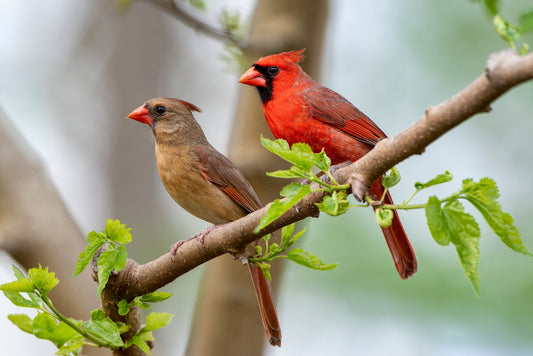-
American Goldfinch (0)
-
American Robin (0)
-
Baltimore Oriole (0)
-
Blue Jay (0)
-
Bluebirds (1)
-
Carolina Wren (0)
-
Chickadee (0)
-
Ducks (0)
-
Starling and House Sparrow (1)
-
House Finch (0)
-
House Wren (0)
-
Hummingbirds (5)
-
Northern Cardinal (1)
-
Northern Mockingbird (0)
-
Nuthatch (0)
-
Owls (3)
-
Tufted Titmouse (0)
-
Woodpeckers (0)
How to Attract Cardinals to Your Backyard: Easy Steps
Attracting birds can be a daunting task when first attempting to get into the hobby. For birdwatchers that are just starting out, especially in the Southeast and Midwest regions of the United States, one bird that can be easily attracted to your backyard is a Northern Cardinal. Although that doesn’t mean the cardinal can’t be spotted farther out west.
With a vibrant red coat of feathers, cardinals bring a welcome pop of color to your yard, even on the dreariest of days. Even though their bright coloration makes them easy to spot, their demeanor is quite the opposite.
Cardinals are known to be shy and may need some encouragement to come check out a new backyard establishment. The great news is that they are non-migratory birds which means they stay in one place all year round. Once cardinals have been attracted to an area, they will stay there as long as their needs are being met.
Attracting cardinals can be easy after learning more about what food they like and how they behave. Here are 6 factors to consider when attracting cardinals:
1. What do cardinals like to eat?
It’s important to remember that not all birds enjoy the exact same thing. What might be yummy to an oriole may not be as appealing to a cardinal. Cardinals have dense heavy duty beaks that were made for crushing thick shells on seeds and nuts. A lot of seeds like safflower, sunflower seeds, shelled peanuts and cracked corn are a safe bet. And if a tree or bush is in the area that produces berries, they will snack on these - and occasionally suet during chillier months.

Like most birds that have new food resources added to the area, it may take some time for cardinals to realize and become comfortable with the new addition. However, once they adjust to the new option, you should see more activity. If you struggle with larger bully birds like starlings or grackles, safflower is a great seed to offer as cardinals enjoy it while starlings and grackles don’t because of the harder shell. This will deter the more aggressive birds from cleaning out your bird feeders.
2. What feeders do cardinals like to use?
Even if all of a cardinal's favorite foods are available you may not see much activity around your birdfeeder. This can be because the feeder that is up now may not be the best style of feeder for cardinals. Cardinals are nervous by nature and can be deterred by feeders that are enclosed or cause them to stretch or twist their bodies. The best style of feeders for cardinals are platform feeders, open tray feeders and hopper style feeders.
Providing feeders that allow for more space and for cardinals to eat facing forward will encourage these skittish birds to the feeder. Some examples of these feeders are the JCS Wildlife Fly Thru Feeder, Hanging Platform Feeder, or Poly Hopper Feeder.
Not only do they provide enough room for cardinals, they are very sturdy, which is important as cardinals are among the larger sized birds that will go to feeders. It is important to have a feeder that can support the weight of a cardinal so it doesn’t bounce around possibly startling the birds.



3. Where should a feeder be placed for cardinals?
Choosing the new dining spot for a cardinal feeder is just as important as what type of seed and feeder. Cardinals are very cautious birds that prefer to have some coverage nearby to their feeders. By having coverage nearby they can stay in the bushes to check to see if it is safe before flying out to a feeder.
Find a quiet spot in the yard to place feeders to encourage more interest. If other critters like squirrels or raccoons aren’t a problem in the area, feel free to scatter seed on the ground as cardinals will feed from the ground.
In addition to having a safe place to scope out feeders, cardinals enjoy areas to rest where they feel protected. Planting native plants in the area can help to provide shelter as well as a natural resource if fruit bearing trees or bushes are included in the habitat. They prefer having extra coverage instead of being out in the open. While it wouldn’t take your yard out of the running it may deter cardinals from visiting if they don’t feel comfortable.
4. Birds need water sources, too!
This doesn’t just go for cardinals but for all birds. An easy way to increase interest in your yard is to include a water source. Whether it is natural or man made, easy access to water helps to check off another box on a bird's basic needs list. If a natural water source, such as ponds, lakes, rivers or streams, aren’t available there’s no need to worry.
Birds will use the resources available to them. Providing a bird bath like the JCS Wildlife Low Profile Bird Bath or Pedestal Bath will help to attract the attention of plenty of feathered friends in the area.
The key to the best watering hole in the area is making sure that it stays clean. It's called a bird bath for a reason. While it is the popular spot to get a drink it can also be the only option for birds to bathe in. Help keep the birds healthy by dumping out old dirty water and cleaning the bird bath bowl before adding new fresh water.

Water is necessary throughout the year to make sure birds are staying hydrated. To keep their favorite watering hole open year round, especially for the non-migratory cardinal, consider using a bird bath de-icer or heated bird bath to keep fresh water throughout each season. The birds will thank you.
5. Providing safe shelter and options for nesting sites
As mentioned before, cardinals are shy birds that depend on the coverage of plants, trees, and bushes for shelter. This goes hand in hand with their preferences for nesting sites. Cardinals, unlike other birds, will not use a birdhouse to nest in.
The very same trees and bushes they run for cover to when startled at a feeder are the same places they will choose to nest. Making nesting materials available for birds can increase the chances of cardinals sticking around the area. Small twigs, old leaves, and even grass clippings can all be used to build a nest. However, cardinals can be quite resourceful in their building materials and have used down, tall grass, fur, bark, and even paper to construct their nests.
Many avid cardinal lovers will be familiar with the term “birdscaping” or the act of designing the surrounding area to be a haven for birds by planting a variety of berried plants in your backyard so that birds will stop by and eat them. By planting native plants, especially fruit bearing bushes and shrubs, you are birdscaping for success.
6. The early bird gets the worm and comes back later for seconds
Being an early riser does mean that cardinals have a better chance of getting more of the seed that they want. They will be one of the first birds to visit feeders everyday. By making sure feeders have fresh seed in them in the morning or planning ahead the evening before you are sure to see more activity at the feeder.
However, that doesn’t mean that you won’t see cardinals in the evening. They are known to “close down the place” and be the last bird to leave as the sun sets. Rest assured that once you have attracted your cardinals the best way to keep them from having a wandering eye is to ensure feeders are full of fresh seed.

No comments







0 comments